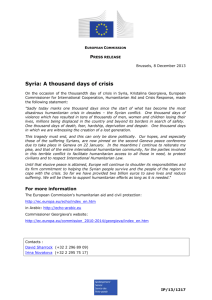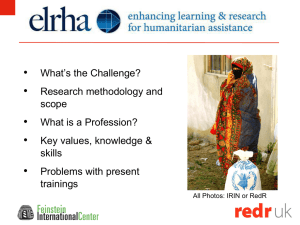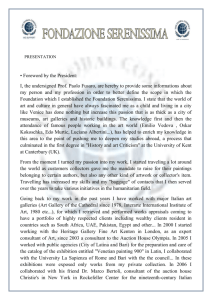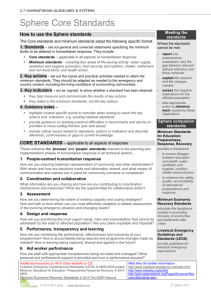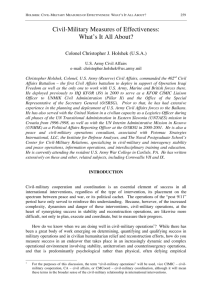Annex 5.7.14 Civil-military relations
advertisement
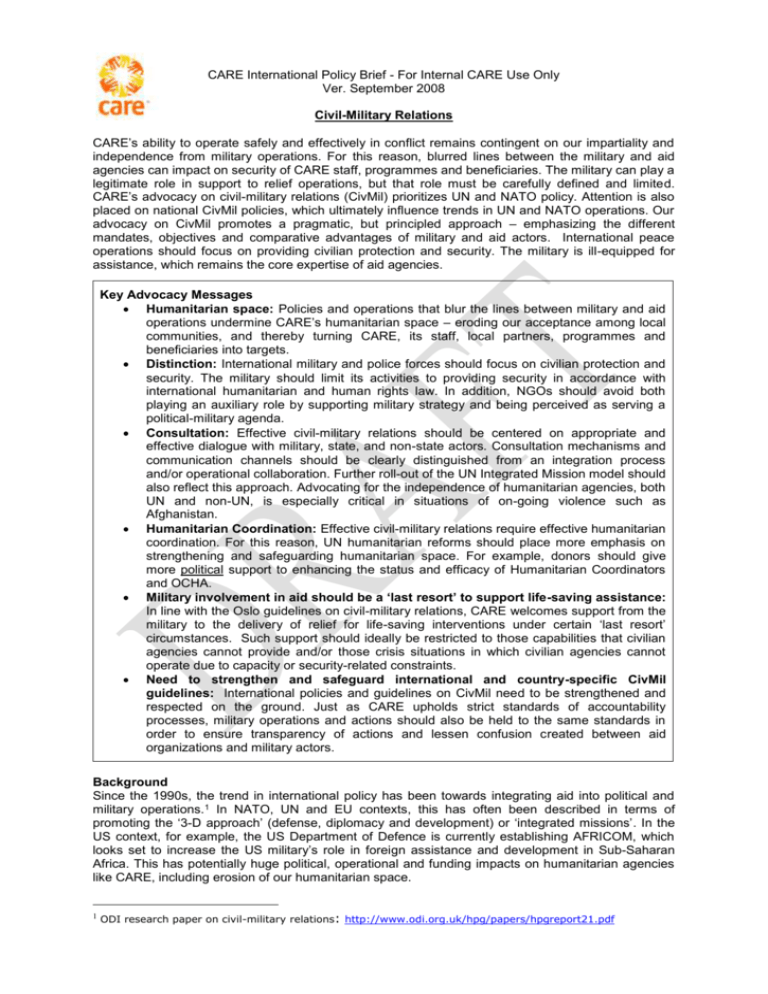
CARE International Policy Brief - For Internal CARE Use Only Ver. September 2008 Civil-Military Relations CARE’s ability to operate safely and effectively in conflict remains contingent on our impartiality and independence from military operations. For this reason, blurred lines between the military and aid agencies can impact on security of CARE staff, programmes and beneficiaries. The military can play a legitimate role in support to relief operations, but that role must be carefully defined and limited. CARE’s advocacy on civil-military relations (CivMil) prioritizes UN and NATO policy. Attention is also placed on national CivMil policies, which ultimately influence trends in UN and NATO operations. Our advocacy on CivMil promotes a pragmatic, but principled approach – emphasizing the different mandates, objectives and comparative advantages of military and aid actors. International peace operations should focus on providing civilian protection and security. The military is ill-equipped for assistance, which remains the core expertise of aid agencies. Key Advocacy Messages Humanitarian space: Policies and operations that blur the lines between military and aid operations undermine CARE’s humanitarian space – eroding our acceptance among local communities, and thereby turning CARE, its staff, local partners, programmes and beneficiaries into targets. Distinction: International military and police forces should focus on civilian protection and security. The military should limit its activities to providing security in accordance with international humanitarian and human rights law. In addition, NGOs should avoid both playing an auxiliary role by supporting military strategy and being perceived as serving a political-military agenda. Consultation: Effective civil-military relations should be centered on appropriate and effective dialogue with military, state, and non-state actors. Consultation mechanisms and communication channels should be clearly distinguished from an integration process and/or operational collaboration. Further roll-out of the UN Integrated Mission model should also reflect this approach. Advocating for the independence of humanitarian agencies, both UN and non-UN, is especially critical in situations of on-going violence such as Afghanistan. Humanitarian Coordination: Effective civil-military relations require effective humanitarian coordination. For this reason, UN humanitarian reforms should place more emphasis on strengthening and safeguarding humanitarian space. For example, donors should give more political support to enhancing the status and efficacy of Humanitarian Coordinators and OCHA. Military involvement in aid should be a ‘last resort’ to support life-saving assistance: In line with the Oslo guidelines on civil-military relations, CARE welcomes support from the military to the delivery of relief for life-saving interventions under certain ‘last resort’ circumstances. Such support should ideally be restricted to those capabilities that civilian agencies cannot provide and/or those crisis situations in which civilian agencies cannot operate due to capacity or security-related constraints. Need to strengthen and safeguard international and country-specific CivMil guidelines: International policies and guidelines on CivMil need to be strengthened and respected on the ground. Just as CARE upholds strict standards of accountability processes, military operations and actions should also be held to the same standards in order to ensure transparency of actions and lessen confusion created between aid organizations and military actors. Background Since the 1990s, the trend in international policy has been towards integrating aid into political and military operations.1 In NATO, UN and EU contexts, this has often been described in terms of promoting the ‘3-D approach’ (defense, diplomacy and development) or ‘integrated missions’. In the US context, for example, the US Department of Defence is currently establishing AFRICOM, which looks set to increase the US military’s role in foreign assistance and development in Sub-Saharan Africa. This has potentially huge political, operational and funding impacts on humanitarian agencies like CARE, including erosion of our humanitarian space. 1 ODI research paper on civil-military relations: http://www.odi.org.uk/hpg/papers/hpgreport21.pdf Often termed ‘CIMIC’, NATO defines civil-military relations in terms of delivering on the military commander’s mission. A key element of CIMIC strategies is the implementation or funding of quick impact projects (QIP). Military QIPs are typically driven by purported ‘force protection’ or ‘hearts and minds’ benefits, rather than humanitarian needs. However, notwithstanding these trends, the difficulties of Coalition interventions in Iraq and Afghanistan are leading to recognition of the counterproductive consequences of military-led strategies in what they term ‘stabilization and reconstruction’. Some senior NATO policy-makers do increasingly acknowledge that, for the military, CIMIC should be about “coordination with, not coordination of” aid agencies. CARE’s advocacy on UN peace operations has emphasized that the military’s primary mandate is to provide security and protection to the civilian population. In contrast, aid should be delivered by civilian agencies who can guarantee their activities are based on impartiality, neutrality, and a need based-approach. For CARE, CivMil processes should consist of consultation and dialogue which enables aid agencies to operate safely and effectively on the basis of their humanitarian principles. International humanitarian law, as well as UN and EU guidelines on CivMil provide important policy frameworks and international norms, which can be used in advocacy regarding military operations in different contexts. The standard references for NGO policy reside in the Red Cross Code of Conduct and the following UN operational guidelines2: Four Geneva Conventions and their additional protocols IASC reference paper on civil-military relationship in complex emergencies MCDA Guidelines on the Use of Military and Civil Defence (2003) Oslo guidelines on the Use of Military and Civil Defence Assets in Disaster Relief (2006) (covering natural, technological and environmental emergencies) Guidelines on Use of Military or Armed Escorts for Humanitarian Convoys (2001) The respect of humanitarian law and humanitarian principles by all parties involved is central to obtaining access to beneficiary communities and to enjoying respect and protection from warring parties. Any perception that an NGO, such as CARE, is aligned with one side in a conflict can compromise its acceptance by the local population as well as by other actors involved. Case Study: Afghanistan Across all provinces in Afghanistan, NGOs deliver assistance in the midst of violence and political instability. Their ability to implement programmes safely and effectively is increasingly jeopardised by the deteriorating security situation. In some districts, NGOs have significantly reduced their operations or even withdrawn entirely as their staff, projects and beneficiaries come under attack. A critical factor in the Afghanistan context is the presence of international military forces (NATO and Coalition) and their use of aid in their strategy to ‘win hearts and minds’. Increasingly, however, NATO and Coalition policy-makers recognize that a short-term approach to using ‘quick impact projects’ for military purposes is ineffective and even counter-productive. For this reason, international policy increasingly emphasizes the need for a ‘Comprehensive Approach’ which involves greater investment in civilian expertise and capacity to implement reconstruction. CARE participates in the Afghanistan ‘NGO civil-military relations working-group’, which is chaired by ACBAR and hosted by UNAMA in Kabul. The group is attended by NATO ISAF and Coalition representatives. Its objectives are to facilitate dialogue in order to address concerns regarding ‘bad practice’ (e.g. military CIMIC activities that blur the lines with or impact negatively on aid programmes), and share information of relevance to NGO safety and security. Critical to the on-going sustainability of this working-group is its facilitation through a third-party actor (ie. UN). Equally important is the group’s careful demarcation as a forum for appropriate dialogue that respects and maintains the neutrality of aid agencies. No information can be discussed that could be perceived as alignment or intelligence-sharing with the military. In 2007/8, the British and Irish Agencies Afghanistan Group (BAAG) and the European Network of NGOs in Afghanistan (ENNA) commissioned an independent research report to better understand the dynamics of civil-military relations on the ground. The research – ‘Afghan Hearts, Afghan Minds: Exploring Afghan Perceptions of Civil-Military Relations’ – focused on experiences in Paktia and Uruzgan. Key findings from the research include: Governance and Security: The military emphasis on using aid to ‘win hearts and minds’ and promote security as part of their stabilisation strategy is misplaced, and even counter2 UN policy documents: http://ochaonline.un.org/webpage.asp?MenuID=12120&Page=774 productive in some instances. Ending the violence in Afghanistan requires a much greater focus on the political challenges related to the country’s ‘rule of impunity’ and conflict between power-holders at national and local levels. Involvment by the military in development places beneficiaries, projects and implementors at risk: Inappropriate associations between the military and some NGOs create security risks for the wider NGO community and local beneficiaries. Military forces should stop instrumentalising NGOs to deliver on their short-term ‘hearts and minds’ objectives; and take greater steps to minimise risks incurred through their interactions with civilian agencies. Effective development outcomes versus military ‘quick impact’ projects: Afghan communities want long-term development assistance based on transparency, accountability and local ownership. Such approaches are not compatible with the short-term imperatives which drive the military’s stabilisation strategy. The military’s use of often costly, ineffective and unaccountable implementing partners is also highly problematic. Donors should rather invest in civilian-led and sustainable programmes, with a focus on building local capacities. ‘Afghanisation’: Policy and practice of both the military and civilian agencies need to be more informed and inclusive of Afghan perspectives. Military operations are inadequately sensitive to Afghan social and cultural norms which define notions of an individual or community’s security and dignity. Donors and humanitarian agencies need to invest more in cross-cultural translation of the humanitarian principles of neutrality, impartiality and independence, and in access negotiations with all parties in the conflict. CARE and Civil-Military Relations Humanitarian space constitutes a priority issue in CARE International’s humanitarian advocacy strategy, and within that civil-military relations features as a central theme. Based on collaboration across the CI federation, CARE has played a leading role in the NGO sector on CivMil advocacy. At the field level, civil-military relations are a critical challenge for many CARE COs. For example, both CARE Sudan and CARE Afghanistan have played leading roles in NGO efforts to negotiate the terms of engagement and dialogue with international military operations in their national context. CI’s Brussels office has engaged in EU advocacy on CIVMIL by leading NGO input to the EU Humanitarian Communication on the topic (eg. presenting on the issue at a hearing in the European Parliament). CARE also played a leading role in a major VOICE and ICVA seminar on civil-military relations in December 2007 at which over 60 NGO experts discussed CivMil operational and advocacy strategy. CIUK participates in the UK NGO-Military Contact Group, and VOICE’s panEuropean working-group on civil-military relations. In the USA, CARE-US participates in the INTERACTION CivMil working-group, and is developing research on AFRICOM, the new US civilmilitary command structure in Africa. CARE Austria participates regularly as NGO informant in Austrian military training courses. NATO’s HQ ARRC has been in contact with CEG to discuss relations between CARE and NATO. CARE is currently finalizing an official policy and operational guidelines on Civil-Military Relations that will ensure uniform guidelines and responses to civil-military issues for all CARE International Staff. A summary of this internal policy is already in the CARE Emergency Toolkit. CARE also strives to ensure that emergency preparedness planning (EPP) for all COs is informed of civil-military relations in the given context.




